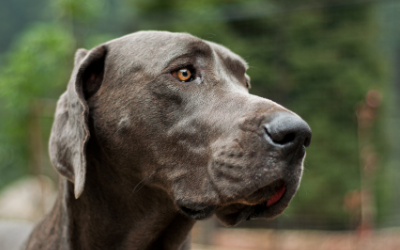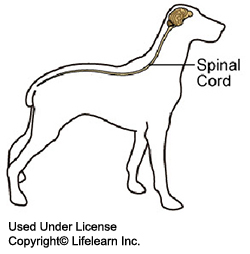What is cervical stenosis?
Cervical stenosis, also known as cervical vertebral instability, cervical spondylopathy or wobbler syndrome, is caused by compression of the spinal cord, usually at the base of the neck.
How does it affect dogs?
Although the spinal cord compression occurs in the neck, the hind legs are often affected first. The mildest form of cervical stenosis results in stumbling or irregular walking or running.
"In severe cases, the dog may suddenly develop total paralysis of all four limbs."
This can progress to a wobbly gait, hence the term wobbler syndrome. In severe cases, the dog may suddenly develop total paralysis of all four limbs.
What causes cervical stenosis?
One or more of the vertebrae at the base of the neck (cervical vertebrae) may be deformed or otherwise develop instability, putting abnormal pressure on the spinal cord. This compression damages the nerves transmitting information to the limbs and therefore paresis (weakness) or paralysis can occur.
My dog suddenly became paralyzed. Is this part of the disease?
Initially the pressure affects your dog's ability to move normally, but this slight incoordination may be difficult to detect. The incoordination, however slight, can put extra stress on the intervertebral discs that act as shock absorbers. If these discs rupture, they put sudden and excessive pressure on the spinal cord and sudden paralysis may result.
I am told that only large breed dogs are affected. Is this true?
Yes. The condition is most prevalent in the Great Dane and the Doberman Pinscher, but Basset Hounds, Saint Bernards, Old English Sheepdogs, Borzois, and Pointers are also commonly affected.
There appears to be variation of the age of onset based on breed. For example, Great Danes are usually affected when they are young, about one to three years of age, whereas Doberman Pinschers and other breeds are usually six to nine years of age before any signs are apparent.
How is the condition diagnosed?
Breed and clinical signs are good indicators of cervical stenosis. With your dog anesthetized or sedated, radiographs (X-rays) of the neck will often reveal abnormalities affecting the vertebrae at the base of the cervical spine. Definitive diagnosis requires myelography, computed tomography (CT) scans or magnetic resonance imaging (MRI).
"Myelography is the most common diagnostic test performed."
Myelography is the most common diagnostic test performed. For this procedure, a special radiopaque solution is injected into the fluid surrounding the spinal cord and a series of X-rays are then taken of the spine. The area of compression is indicated by a thinning of the column of dye at the pressure points.
What is the treatment for cervical stenosis?
Anti-inflammatory drugs and analgesics may relieve the initial discomfort, but the greatest chance of success lies with surgery, particularly if performed early in the course of disease. Although some dogs respond very well to medication alone, its continued long-term use may create undesirable side effects.
What does surgical treatment involve?
It is important that pressure on the spinal cord be relieved as soon as possible. Medical treatment with anti-inflammatory drugs reduces the pressure due to inflammation, but this will not resolve the problem if there is a deformed vertebra or disc material pressing on the spinal cord.
There are several surgical techniques that can be used to relieve the pressure. If the surgery is performed at an early stage, before irreversible damage has occurred, the outlook can be quite good. Normally this surgery will be performed by a board-certified veterinary surgeon. The surgeon will determine the most appropriate technique for your pet, and will discuss your options, the risks, and the long-term prognosis.
What is the post-operative care?
Most surgeons insist on hospitalization for several days following surgery.
After discharge, it is important that the dog receives help with walking; the dog must not be allowed to climb steps or stairs for some time once at home. An appropriate physical therapy program will be designed specifically for your dog. Your veterinarian will discuss the specific nursing care of your pet with you.
Is the condition likely to occur again after surgery?
This is dependent on your pet's specific condition. If there is an inherent weakness in the spine, it is possible for the condition to recur. However, with modern surgical techniques, this is not common and most pets enjoy a relatively normal lifestyle following surgery.

